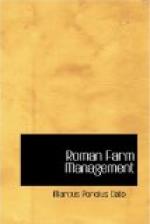6 deg. CONSUMING TIME
LXII. Since no one stores his crops except to bring them out again, it remains to make a few observations upon the sixth and last operation in our round of agriculture.
Crops which have been stored are brought out either to care for them, to consume them or to sell them, and as all crops are not alike there are different times for caring for them and for consuming them.
Of cleaning grain
LXIII. Grain is taken out of store to be cleaned, when the weevil begins to damage it. When this is apparent the grain should be laid out in the sun and bowls of water placed nearby and the weevil will swarm on this water and drown themselves. Those who store their grain in the pits which are called silos should not attempt to bring out the grain for some time after the silo has been opened because there is danger of suffocation in entering a recently opened silo. The corn which, during the harvest time, you stored in the ear and which you contemplate using for food, should be brought out during the winter to be crushed and ground in the grist mill.
Of condensing amurca
LXIV. When it flows from the oil mill, amurca is a watery fluid full of dregs. It is the custom to store it in this state in earthen jars and fifteen days later to skim off the scum from the top and transfer this to other jars, an operation which is repeated at regular intervals twelve times during the following six months, taking care that the last skimming is done on the wane of the moon. Then it is boiled in a copper kettle over a slow fire until it is reduced two-thirds, when it may be drawn off for use.
Of racking wine
LXV. When the must is stored in the vat to make wine, it should not be racked off while it is fermenting nor until this process has advanced so far that the wine may be considered to be made. If you wish to drink old wine, it is not made until a year is completed; when it is a year old, then draw it out. But if your vineyard contains that kind of grape which turns sour early, you should eat the fruit, or sell it before the succeeding vintage. There are kinds of wine, like that of Falernum, which improve the longer you keep them.
Of preserved olives
LXVI. If you attempt to eat white olives immediately after you have put them up and before they are cured your palate will reject them on account of their bitterness (and the same is true of the black olive) unless you dip them in salt to make them palatable.
Of nuts, dates and figs
LXVII. The sooner you use nuts, dates and figs after they have been stored, the more palatable they will be, for by keeping figs lose their flavour, dates rot and nuts dry up.
Of stored fruits
LXVIII. Fruits which are strung, such as grapes, apples and sorbs show by their appearance when they may be taken down for use, for by their change of colour and shrinking they reveal themselves as destined to the garbage pile unless they are eaten in time. Sorbs which have been laid by when they are already dead-ripe should be used promptly, but those which were picked green are slower to decay: for green fruit in the store house must there go through the process of ripening which was denied it on the tree.




